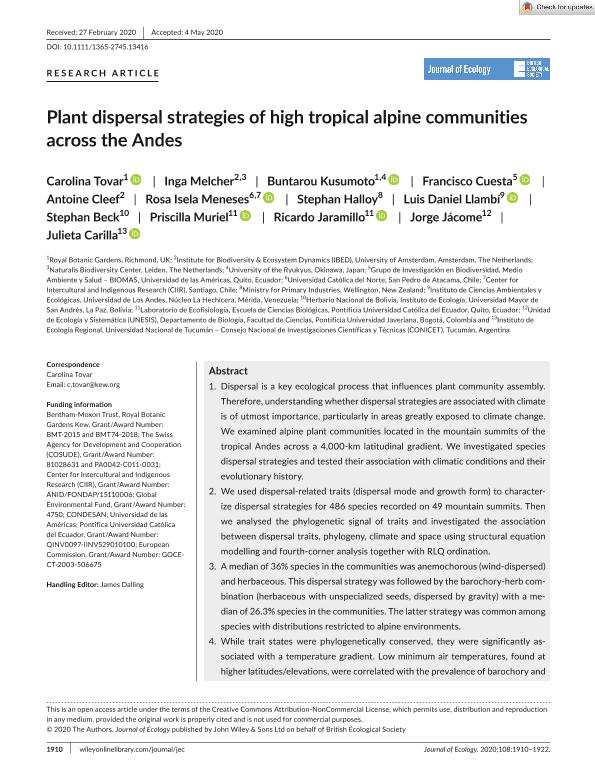Artículo
Plant dispersal strategies of high tropical alpine communities across the Andes
Tovar, Carolina; Melcher, Inga; Kusumoto, Buntarou; Cuesta, Francisco; Cleef, Antoine; Meneses, Rosa Isela; Halloy, Stephan; Llambi, Luis Daniel; Beck, Stephan G.; Muriel, Priscilla; Jaramillo, Ricardo Luis; Jacome, Jorge; Carilla, Julieta

Fecha de publicación:
09/2020
Editorial:
Wiley Blackwell Publishing, Inc
Revista:
Journal of Ecology
ISSN:
0022-0477
Idioma:
Inglés
Tipo de recurso:
Artículo publicado
Clasificación temática:
Resumen
Dispersal is a key ecological process that influences plant community assembly. Therefore, understanding whether dispersal strategies are associated with climate is of utmost importance, particularly in areas greatly exposed to climate change. We examined alpine plant communities located in the mountain summits of the tropical Andes across a 4,000-km latitudinal gradient. We investigated species dispersal strategies and tested their association with climatic conditions and their evolutionary history. We used dispersal-related traits (dispersal mode and growth form) to characterize dispersal strategies for 486 species recorded on 49 mountain summits. Then we analysed the phylogenetic signal of traits and investigated the association between dispersal traits, phylogeny, climate and space using structural equation modelling and fourth-corner analysis together with RLQ ordination. A median of 36% species in the communities was anemochorous (wind-dispersed) and herbaceous. This dispersal strategy was followed by the barochory-herb combination (herbaceous with unspecialized seeds, dispersed by gravity) with a median of 26.3% species in the communities. The latter strategy was common among species with distributions restricted to alpine environments. While trait states were phylogenetically conserved, they were significantly associated with a temperature gradient. Low minimum air temperatures, found at higher latitudes/elevations, were correlated with the prevalence of barochory and the herb growth form, traits that are common among Caryophyllales, Brassicaceae and Poaceae. Milder temperatures, found at lower latitudes/elevations, were associated with endozoochorous, shrub species mostly from the Ericaceae family. Anemochorous species were found all along the temperature gradient, possibly due to the success of anemochorous Compositae species in alpine regions. We also found that trait state dominance was more associated with the climatic conditions of the summit than with community phylogenetic structure. Although the evolutionary history of the tropical Andean flora has also shaped dispersal strategies, our results suggest that the environment had a more predominant role. Synthesis. We showed that dispersal-related traits are strongly associated with a gradient of minimum air temperatures in the Andes. Global warming may weaken this key filter at tropical alpine summits, potentially altering community dispersal strategies in this region and thus, plant community structure and composition.
Archivos asociados
Licencia
Identificadores
Colecciones
Articulos(IER)
Articulos de INSTITUTO DE ECOLOGIA REGIONAL
Articulos de INSTITUTO DE ECOLOGIA REGIONAL
Citación
Tovar, Carolina; Melcher, Inga; Kusumoto, Buntarou; Cuesta, Francisco; Cleef, Antoine; et al.; Plant dispersal strategies of high tropical alpine communities across the Andes; Wiley Blackwell Publishing, Inc; Journal of Ecology; 108; 5; 9-2020; 1910-1922
Compartir
Altmétricas



